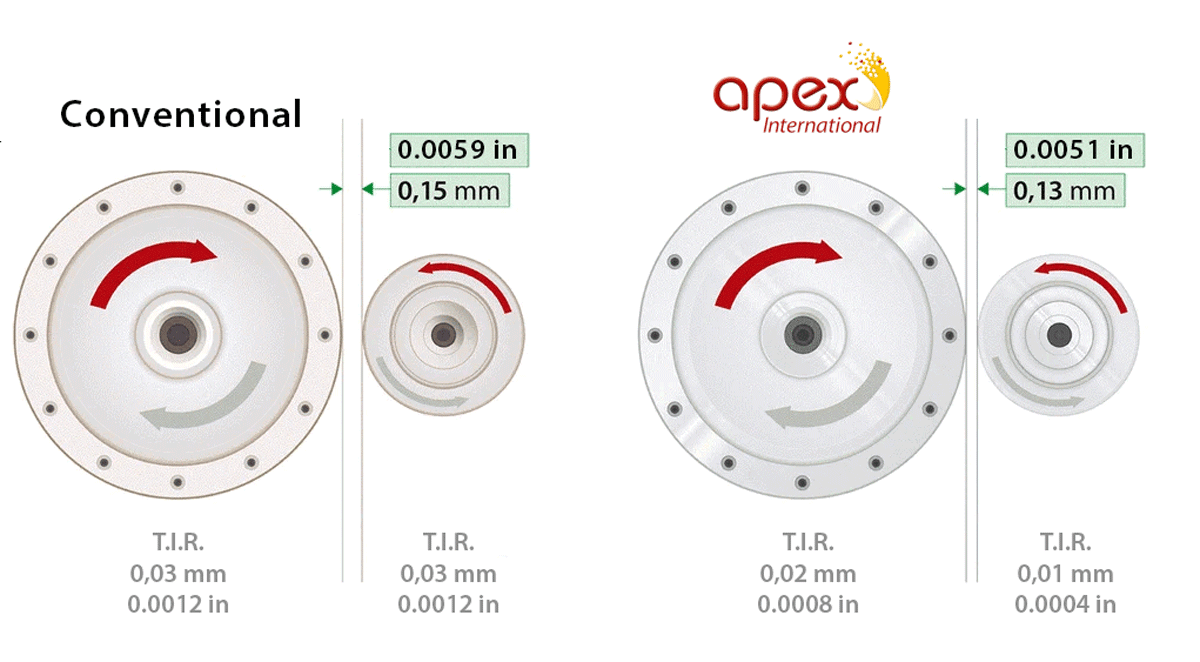
Efficient glue application is critical in corrugated board manufacturing, directly impacting board quality, energy consumption, and overall profitability. Applying too much glue can result in warping, washboarding, uneven bonding, and higher energy costs due to excess moisture that must be dried. On the other hand, too little glue can cause weak bonds, delamination, and increased waste, negatively affecting production efficiency and margins.
 To optimize glue application and improve corrugated board quality, close attention should be paid to glue set performance and specifications. Key factors include:
To optimize glue application and improve corrugated board quality, close attention should be paid to glue set performance and specifications. Key factors include:
-
- TIR (Total Indicated Runout): Low TIR enables a reduced glue gap, ensuring more consistent glue application and minimizing uneven bonding across the board.
- Doctor Roll Surface Hardness: Harder surfaces help eliminate score lines and provide a uniform metering layer, increasing application precision and extending the life of the glue set.
- Applicator Roll Material: Stainless steel applicator rolls resist corrosion and wear, helping maintain consistent transfer rates and surface integrity over time.
The Role of Glue Roll Engraving
 The engraving on the glue roll plays a crucial role in determining both the evenness and volume of the glue layer. Most standard applicator rolls feature 30 LPI (12 L/cm) with an estimated 65 BCM (101 Cm3/m2) volume. However, not every application is the same. It's important to evaluate whether the same roll type is optimal for different gluing units and flute types.
The engraving on the glue roll plays a crucial role in determining both the evenness and volume of the glue layer. Most standard applicator rolls feature 30 LPI (12 L/cm) with an estimated 65 BCM (101 Cm3/m2) volume. However, not every application is the same. It's important to evaluate whether the same roll type is optimal for different gluing units and flute types.
The goal is to apply the least amount of glue necessary while still meeting the required board strength and visual standards.
Single Facer vs. Double Backer Glue Application
Single Facer Unit:-
- Dwell Time: Short interval between glue application and flute-to-liner contact leaves little time for absorption or drying.
- Pressure: Higher nip pressure ensures bond integrity despite minimal glue.
-
- Dwell Time: Longer wait before flute contact with the liner allows for more glue absorption, often requiring higher initial glue volume.
- Pressure: Minimal pressure is used to avoid crushing, making precise glue metering even more critical.
Given these differences, lower glue application may be required for the single facer to achieve strong bonding and prevent board warping. This can be controlled by modifying the glue gap, assuming the TIR of the glue set rolls is tight, or by selecting a glue roll with a different screen and volume. Optimizing glue volume and engraving specs for each unit enhances bond quality and reduces energy consumption.
Engraving Selection by Flute Type
 Flute profiles vary by size and count per unit length, which affects glue application needs. For instance, E and F micro-flutes have more contact points than larger A, B, or C flutes, requiring greater precision in glue metering to avoid washboarding or over-gluing.
Flute profiles vary by size and count per unit length, which affects glue application needs. For instance, E and F micro-flutes have more contact points than larger A, B, or C flutes, requiring greater precision in glue metering to avoid washboarding or over-gluing.
While adjusting the glue gap can help control glue transfer, a tighter gap requires excellent TIR to prevent glue set wear and ensure even application. Alternatively, selecting an applicator roll with a different engraving pattern and transfer capacity can provide better control.
Uniform Glue Application Across Corrugator Width
Uneven glue laydown (typically more glue in the center than at the edges) is often caused by pressure buildup between the glue and doctor rolls during production, especially with tighter glue gaps. Large, closed cells in the glue roll can trap glue and create back pressure.
To ensure even glue distribution across the full width, consider the following options:
-
- Crown the doctor roll to compensate for bowing.
- Use open-cell engravings that relieve pressure and deliver consistent glue coverage.
Driving Profitability Through Glue Optimization
 When glue application is optimized, manufacturers benefit from lower glue usage, reduced drying energy, and more efficient downstream processes. Partnering with technical experts to fine-tune your glue application strategy can greatly improve corrugated board performance and operational profitability.
When glue application is optimized, manufacturers benefit from lower glue usage, reduced drying energy, and more efficient downstream processes. Partnering with technical experts to fine-tune your glue application strategy can greatly improve corrugated board performance and operational profitability.
Why Choose Apex International
Apex International offers complete glue set solutions to help corrugated plants optimize board bonding and reduce waste. From precision-engineered rolls to proprietary ceramic coatings and expert support, Apex delivers the tools you need to reduce glue usage, lower energy consumption, and improve board quality and consistency.
 We offer a full range of engraving options from standard 30 LPI (12 L/cm) with an estimated 65 BCM (101 Cm3/m2) to advanced positive screen engravings with volumes as low as 35 BCM (54 Cm3/m2). Whether you’re running a single facer, double backer, or working with various flute profiles, Apex has the right roll for your application.
We offer a full range of engraving options from standard 30 LPI (12 L/cm) with an estimated 65 BCM (101 Cm3/m2) to advanced positive screen engravings with volumes as low as 35 BCM (54 Cm3/m2). Whether you’re running a single facer, double backer, or working with various flute profiles, Apex has the right roll for your application.
Backed by local technical support, fast response times, and world-class product quality, Apex is your trusted partner in corrugator performance.
Contact Apex International today to learn how we can help you improve glue application, enhance corrugated board quality, and boost your bottom line.
Your corrugator. Our expertise. Better board starts here.



